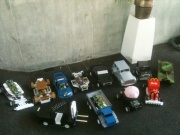Kart
(→Components) |
|||
| Line 24: | Line 24: | ||
* A [[Kart/DC motor controller|DC motor controller]] receives a speed value and builds a PWM and a direction control. | * A [[Kart/DC motor controller|DC motor controller]] receives a speed value and builds a PWM and a direction control. | ||
* A [[Kart/stepper motor controller|stepper motor controller]] receives the desired angle and builds the coil controls signals. | * A [[Kart/stepper motor controller|stepper motor controller]] receives the desired angle and builds the coil controls signals. | ||
| − | * A sensor board manages I/O comprising proximity sensors, hall sensors (for the driving speed) and LEDs. | + | * A [[Kart/sensor board|sensor board]] manages I/O comprising proximity sensors, hall sensors (for the driving speed) and LEDs. |
=== Bluetooth communication === | === Bluetooth communication === | ||
| Line 30: | Line 30: | ||
A receiver chip creates the RS232 signals for the FPGA. | A receiver chip creates the RS232 signals for the FPGA. | ||
The [[kart/serial link#Serial link protocol|protocol]] defines how the [[kart/serial link#Registers|registers]] are accessed. | The [[kart/serial link#Serial link protocol|protocol]] defines how the [[kart/serial link#Registers|registers]] are accessed. | ||
| − | |||
| − | |||
| − | |||
| − | |||
| − | |||
| − | |||
| − | |||
| − | |||
| − | |||
| − | |||
| − | |||
| − | |||
== Components == | == Components == | ||
| Line 53: | Line 41: | ||
* a [[Kart/DC motor controller|DC motor controller]] | * a [[Kart/DC motor controller|DC motor controller]] | ||
* a [[Kart/stepper motor controller|stepper motor controller]] | * a [[Kart/stepper motor controller|stepper motor controller]] | ||
| − | * an [[Kart/sensor board|I/O]] | + | * an [[Kart/sensor board|I/O board]] |
=== Sensors === | === Sensors === | ||
| − | The | + | The sensors connected to the I/O board are: |
* 1 to 4 [[kart/sensors/VCNL4000|VCNL4000 I2C Distance/Ambience Light Sensor]] | * 1 to 4 [[kart/sensors/VCNL4000|VCNL4000 I2C Distance/Ambience Light Sensor]] | ||
* 1 to 2 [[kart/sensors/SS311PT|SS311PT Hall Sensor]] | * 1 to 2 [[kart/sensors/SS311PT|SS311PT Hall Sensor]] | ||
* 1 [[Kart/sensors/HCSR04|ultrasound ranger]] | * 1 [[Kart/sensors/HCSR04|ultrasound ranger]] | ||
| + | * 1 [[Kart/sensor board|end of turn]] contact switch | ||
| + | |||
| + | Additionally, the power supply board comprises an ADC which provides the [[kart/battery level|battery level]]. | ||
== Getting started == | == Getting started == | ||
Revision as of 11:44, 25 July 2014
|
The Kart module is a Summer School module for students between 3. and 4. semester. It's a home-made car remotely controlled by a smart-phone.
The work of the students can be summarized in four main tasks:
- design and build the chassis
- analyse the motor driver circuits (DC and stepper)
- configure the controlling FPGAs
- complete and extend the GUI on the smart-phone
System Architecture
The kart is controlled by a smartphone via Bluetooth.
Distributed boards
A Bluetooth receiver on the kart communicates via an RS232 serial link with the FPGA control board.
The control is distributed over several FPGA boards connected together via I2C:
- An I2C master receives RS232 controls, stores them in a set of registers and dispatches them at a regular interval on the I2C. The master also reads data values from the I2C, stores them into a second set of registers and sends the corresponding information at a regular rate over the RS232.
- A DC motor controller receives a speed value and builds a PWM and a direction control.
- A stepper motor controller receives the desired angle and builds the coil controls signals.
- A sensor board manages I/O comprising proximity sensors, hall sensors (for the driving speed) and LEDs.
Bluetooth communication
A Bluetooth communication transfers serial port data. A receiver chip creates the RS232 signals for the FPGA. The protocol defines how the registers are accessed.
Components
FPGA Boards
The FPGA motherboards are equipped with an AGL125 IGLOO in a VQ100 package. They connect to daughterboards which drive different parts of the Kart. The motherboards are interconnected via an I2C link.
Existing daughterboards are:
Sensors
The sensors connected to the I/O board are:
- 1 to 4 VCNL4000 I2C Distance/Ambience Light Sensor
- 1 to 2 SS311PT Hall Sensor
- 1 ultrasound ranger
- 1 end of turn contact switch
Additionally, the power supply board comprises an ADC which provides the battery level.
Getting started
In order to start the projects you should do the following:
- Read carefully the specifications above
- Consult the student's guide for the first steps
- When preparing the labs, follow the setup guide
Additional Information
- Additional informations for collaborators
- To do list


